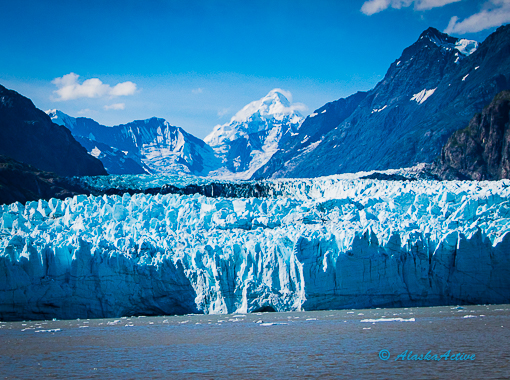|
Glacier Bay Lodge is nestled among Sitka Spruce on the shores of Bartlett Cove at the border to Glacier Bay National Park. The main lobby is spacious and inviting with giant wood beams and cathedral ceilings. Relax in front of the fireplace in the view lounge area, visit the National Park Service's excellent interpretive displays or enjoy walks on nearby trails throughout the rain forest. The restaurant - with outside decks - serves fresh, creatively prepared meals with an emphasis on local seafood favorites such as Dungeness crab, salmon and halibut. Guest rooms are separate from the main lodge and are accessed by boardwalks. Each room features a private bath and/or shower. Activities: National Park Service Rangers lead daily walks directly from the lodge on the Forest Loop Trail. For a longer outing, a 4-mile trail leads you from the lodge to Bartlett River and back. On the way, view an estuary where wildlife and migrating birds are frequently observed. |
GBP#03 Glacier Bay Lodge Package | Alaska Ferry to Gustavus
Tour Itinerary
Dates | Rates
Options | Extensions
Glacier Bay National Park FAQ
|
Day
01 |
 |
Juneau - Gustavus (Alaska Ferry) Start your Glacier Bay package with the morning ferry ride from Juneau to Gustauvs. The Alaska ferry departs at 7 a.m. from Auke Bay and arrives at 12:45 p.m. at Barlett Cove, Gustavus (times subject to change). Enjoy the fast catamaran ride while witnessing some of the most magnificent scenery in the world. Upon arrival you will be transferred to Glacier Bay Lodge where you can check into your room. Spend the rest of the day walking the beach at Bartlett Cove or exploring the rainforest trails that surround the lodge. You can choose to do the Forest Loop Trail, a one-mile long loop trail begins at the Glacier Bay Lodge and ends near the dock. This easy trail winds through a pond-studded spruce/hemlock forest for one half mile, then descends to the beach. The Glacier Bay Lodge offers you a choice of dining at the Fairweather Dining Room or outside on the deck and offers local seafood favorites like Dungeness Crab (a house specialty), halibut and salmon. After dinner, attend a presentation by the National Park Service in preparation for tomorrow's trip. Overnight: Glacier Bay Lodge |
|
Day
02 |
 |
Gustavus - Juneau (Skagway, Haines) / Glacier Bay Day Cruise Depart at 7:30 a.m. for the scenic high-speed catamaran cruise into Glacier Bay, where you will explore the entire length of the West Arm of Glacier Bay to the face of Margerie and Grand Pacific glaciers, two of several tidewater glaciers in the park. Watch the tidewater glaciers "calve" - when enormous chunks of ice fall of the glacier's face and crash dramatically into the water below. As you cruise, observe the park's wildlife: Humpback, orca and minke whales; harbor seals and sea lions; bears, mountain goats and more than 200 species of birds. The spacious, comfortable catamaran was designed for maximum stability, fastest cruising speed and the least wake – making it the perfect vessel design for all-day cruising. The boat is fully enclosed and features comfortable heated seats, large windows for viewing the scenery and wildlife. There is also an expansive outside deck that is easily accessed through several doors. Throughout the cruise, a National Park Service ranger will explain wildlife behavior as well as the geologic features and cultural history of the park. Lunch is included and served on board, along with hot cocoa, tea and coffee. Return at 3:30 p.m. to Bartlett Cove. Transfer to the airport and board the flight to Juneau (or optional Skagway / Haines). An additional night's stay at Glacier Bay Lodge can be arranged. |
| Rates in US $ / per Person | Single | Double | Triple | Quad | Child |
| 2 Days / 1 Night Glacier Bay Lodge Package | $ 1150.00 | $ 955.00 | $ 895.00 | $ 875.00 | $ 575.00 |
| 3 Days / 2 Nights Glacier Bay Lodge Package | $ 1515.00 | $ 1140.00 | $ 1030.00 | $ 980.00 | $ 600.00 |
| 4 Days / 3 Nights Glacier Bay Lodge Package | $ 1880.00 | $ 1325.00 | $ 1165.00 | $ 1000.00 | $ 625.00 |
|
| Rates in US $ / per Person (+ tax) | Single | Double | Triple | Quad | Child |
| May 28 - September 05 - Standard | $ 180.00 | $ 95.00 | $ 67.00 | $ 58.00 | $ 10.00 |
| May 28 - September 05 - Superior | $ 230.00 | $ 115.00 | $ 83.00 | $ 78.00 | $ 10.00 |
| Rates in US $ / per Person | Adult |
| Gustavus: 3 1/2 hour Whale Watching Cruise including tax + $12 per Person Round Trip Transportation |
$ 130.00 |
 |
|||||||||||||||||||||||||||||||||||||||||||||||||||
Glacier BayNational Park - FAQ
|
|||||||||||||||||||||||||||||||||||||||||||||||||||